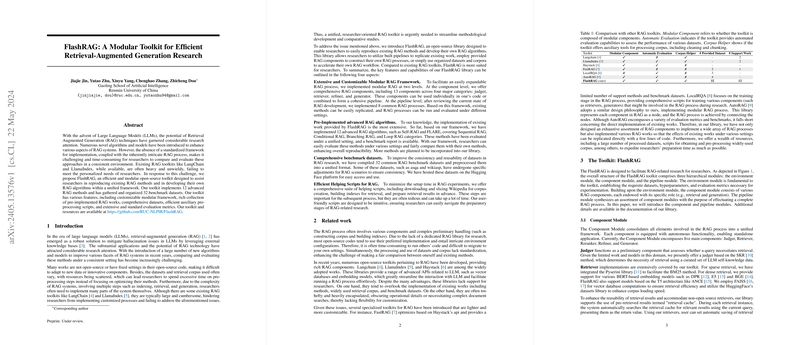FlashRAG: A Modular Approach to Retrieval-Augmented Generation
Overview
FlashRAG is a streamlined, open-source toolkit designed for researchers diving into the world of Retrieval-Augmented Generation (RAG). By offering modular components, pre-implemented algorithms, and extensive datasets, FlashRAG aims to make the complex RAG process more accessible and reproducible. This toolkit seeks to address the unique challenges researchers face when implementing and comparing RAG methods, providing a unified framework that enhances flexibility and reduces the setup time.
Key Features of FlashRAG
Extensive and Customizable Modular Framework
FlashRAG is designed with modularity at its core, making it highly customizable:
- Components: The toolkit includes 13 components across four categories: judger, retriever, refiner, and generator. These can be mixed and matched to form unique pipelines or used individually.
- Pipelines: Eight common RAG processes are pre-implemented, enabling replication of existing methods as well as the development of new ones.
Pre-Implemented Advanced RAG Algorithms
FlashRAG includes implementations of 12 advanced RAG algorithms, covering a variety of methodologies like Sequential RAG, Conditional RAG, Branching RAG, and Loop RAG. This extensive library allows researchers to benchmark these methods against their own in a unified setting.
Comprehensive Benchmark Datasets
To streamline the evaluation process, FlashRAG features 32 benchmark datasets, all pre-processed into a uniform format. These datasets cover various tasks relevant to RAG research, from simple Q&A datasets to complex multi-hop reasoning datasets.
Efficient Auxiliary Pre-Processing Scripts
Setting up RAG experiments can be tedious, so FlashRAG comes with scripts to handle downloading and slicing corpora, building indexes, and preparing retrieval results. This minimizes setup time, letting researchers focus on refining their methods.
Performance and Results
The paper presents an evaluation of several RAG methods using FlashRAG, showing significant improvements over direct generation techniques. Some highlights include:
- Standard RAG Approach: Achieved strong baseline performance across multiple datasets.
- Ret-Robust Generator: Leveraged a trained generator to outperform other methods on several benchmarks.
- Iterative Methods: Showed particular strengths on complex datasets requiring multi-step reasoning.
Impact of Retrieval on RAG Performance
The paper delved into how the quantity and quality of retrieved documents affect the overall performance of the RAG process. Interestingly, retrieving 3 to 5 documents generally yielded the best results, emphasizing the balance between the quality of retrieved documents and noise.
Practical Implications
FlashRAG is well-suited for researchers looking to:
- Reproduce Existing Work: Easily replicate and build upon existing RAG methods.
- Develop New Techniques: Employ a flexible and modular framework to test new RAG algorithms.
- Benchmark and Compare: Use consistent datasets and evaluation metrics to fairly compare various RAG methods.
Future Outlook
As RAG techniques continue to evolve, FlashRAG's flexible and modular design positions it as a valuable tool for researchers. Future developments may include expanding the library of pre-implemented methods and adding support for training RAG components, which could further streamline the development process for new algorithms.
Conclusion
FlashRAG addresses significant pain points in RAG research by providing a unified, modular toolkit that enhances reproducibility and reduces setup time. Whether you're looking to benchmark existing methods or develop new ones, FlashRAG provides the tools and resources needed to accelerate your research in retrieval-augmented generation.
